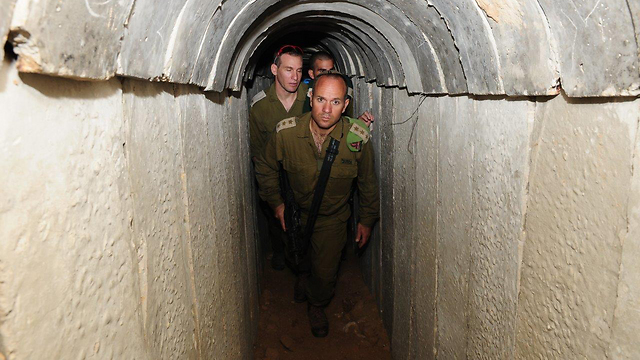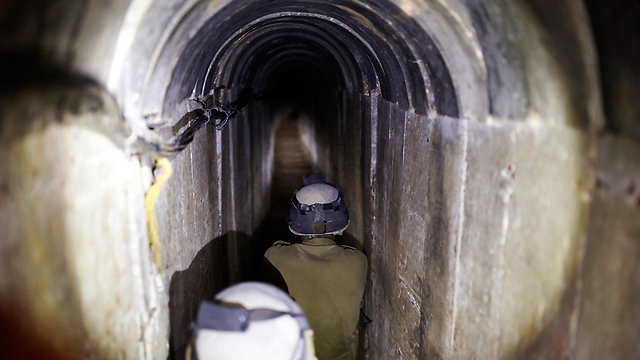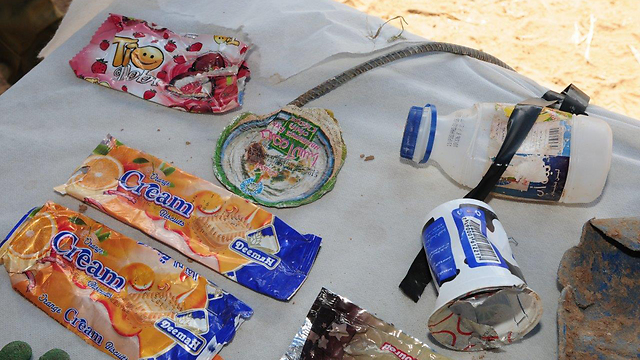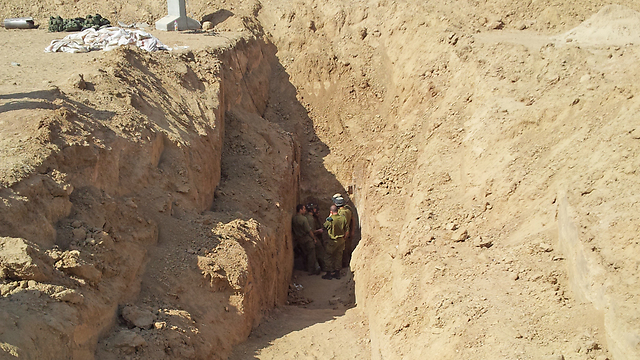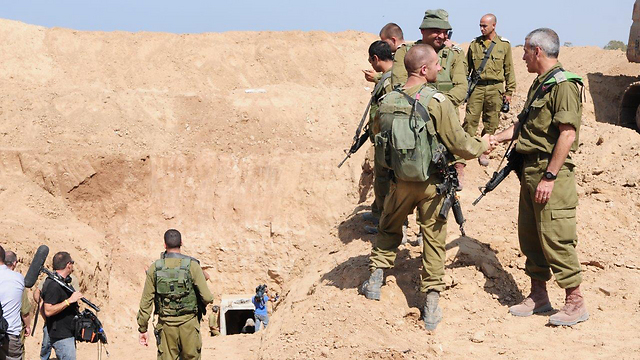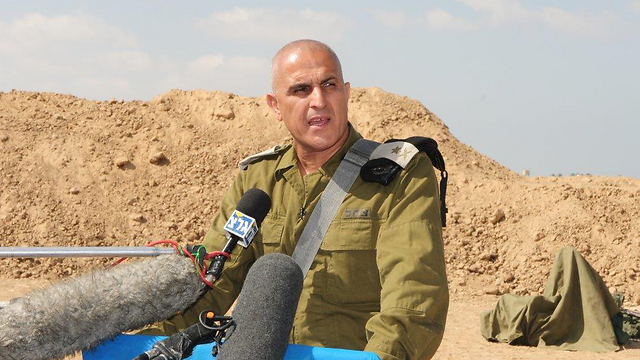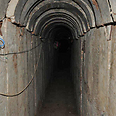
Israeli cement, cables, candy wrappers: Inside the tunnel
IDF reports uncovered tunnel on Gaza border reached depth of 22 meters, dug over two years, never completed. 'Builders, planners – everyone will pay the price,' major general promises
They were digging for two years. Using hammers, drills and shovels, laying thousands of arches and cement blocks – some Israeli made – with an overall weight of 500 tons, laying electrical and phone cables.
The tunnel exposed last week by the IDF on the border with the Gaza Strip was exceptionally sophisticated and long, measuring approximately 1.7 km.
Related stories:
- Gaza tunnels idle amid Egypt crackdown
- Egyptian army says destroyed 102 Gaza tunnels
- IDF uncovers terror tunnel in Israel
"This is the first time we pinpoint the location of a tunnel and expose it," a top defense official said on Sunday. Over the last few days large engineering forces employed bulldozers and trucks to uncover the tunnel's openings and trajectory, and revealed a tunnel of astounding sophistication.
Inside the tunnel (Photo: Herzl Yosef)
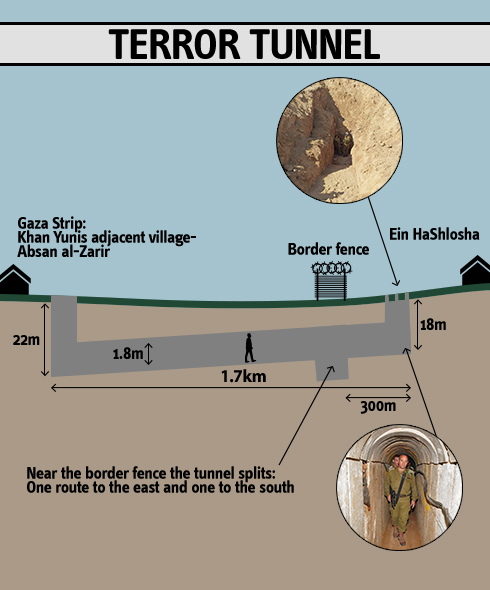
(Photo: Herzl Yosef)
The tunnel starts near the village of Absan al-Zarir, east of Khan Yunis. The exit – 300 meters inside Israeli territory, in an uncultivated wheat field.
The tunnel's average depth is 18 meters, and it reached a maximum depth of 22 meters below ground on the Palestinian side. Inside, the tunnel was high enough to allow a man to walk freely.
The cables which lined the tunnel walls allowed for uninterrupted communications with base, as well as ample lighting with energy-saving halogens.
Bags of construction material, some of it Egyptian-made, show that the construction was not over, and it is unclear how far into Israel the Palestinians planned to go. The builders inscribed the walls with their names.
Soldiers found various edibles and wrappings inside the tunnel, which testify to the long time the builders most likely spent inside: Sausages, chocolate wrappers dated to June, and a dairy-beverage which expired at 22/6/2013.
Intelligence estimates, thorough exploration
The tunnel was not exposed by accident, as in previous cases, but due to Gaza Division and Southern Command estimations and ground reports from patrols.
In January 2013, several weeks after Operation Pillar of Defense ended, a large tunnel collapsed in Israeli territory near the border fence as a result of rain-induced floods in the area. IDF troops were called in to the area, and discovered the tunnel was part of a vast system of burrows, thereby estimating that many other tunnels might be stretching from the Gaza Strip into Israeli territory.
The Gaza Brigade set out to trace any other tunnels Gazans may have built, utilizing intelligence and technological tools.
Lost and found – wrappers from the tunnel (Photo: Herzl Yosef)
Tool found in the tunnel (Photo: Herzl Yosef)
Average depth: 18 meters (Photo: Herzl Yosef)
Some two weeks ago, engineering troops had started scouring a wheat field between Ein Hashlosha and the border fence. Following a thorough exploratory operation of several hundred meters, the troops determined a tunnel was underneath the field.
The site was then isolated and declared a closed military zone. Golani Brigade and Armored Corps secured the compound, as bulldozers exposed the underground routes. Combat soldiers then entered the tunnels to ensure that no explosives were placed in the burrows.
Southern Command Chief Maj. Gen. Sami Turgeman noted that this is the third tunnel exposed this year and warned: "This is a gross breach of Israeli sovereignty, and if Hamas realizes its terrorist intentions, especially using a tunnel, it will pay a heavy price, and the Gaza Strip will not be the same."
According to Turgeman, "They're digging many tunnels and it's a large industry which includes house and land renters, planners, diggers and engineers. It's a bona-fide terror industry, and all parties, from the laborers to the planners, will pay the price."
(Photo: Herzl Yosef)
(Photo: Herzl Yosef)
(Photo: Herzl Yosef)
Turgeman recently said that Hamas has been functioning as a restraining factor in the Strip since the Israeli Pillar of Defense operation in November 2012, and repeated this comment on Sunday morning as well. The major general noted that the group still prevents attacks against Israel, but added some criticism: "Hamas invests tens of millions of dollars in digging tunnels instead of investing them in the community, in building houses and schools, businesses and industry."
Maj. Gen. Turgeman (Photo: Herzl Yosef)
"Hamas continues to become stronger and fortify, and has been cynically taking advantage of our good intentions when we let construction materials in the Strip for the private sector, for civilians."
Following the tunnel's exposure, the Coordinator of Government Activities in the Territories (COGAT) Eitan Dangot ordered construction material shipments to the Strip ceased until further notice.
Turgeman noted that tunnels of the kind exposed could be used for abduction, attacks against IDF forces or against civilian targets: "The tunnel can be active all the time, not only in times of warfare. Hamas is under pressure after losing its strategic support, the Muslim Brotherhood in Cairo."
The major general added that the Egyptians are currently at work, "severing the Sinai Peninsula from the Strip."
The spokesman for Hamas' military wing, the Izz al-Din al-Qassam Brigades, commented on the tunnel discovery, "The desire in the minds and hearts of the resistance members is much more important than the tunnels that are dug in the ground. This desire is capable of producing thousands of tunnels."
The Popular Resistance Committee said that the allegations in Israel regarding the tunnel discovery are an attempt to justify future military aggression against the Gaza Strip. The group made it clear that the discovery of the tunnel proves Gaza intends to continue its operations with the goal of abducting Israeli soldiers to be used in Palestinian prisoner swaps.
- Receive Ynetnews updates directly to your desktop










